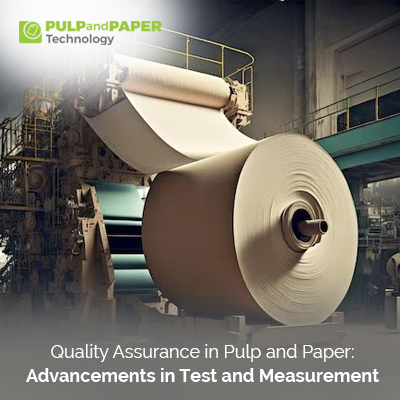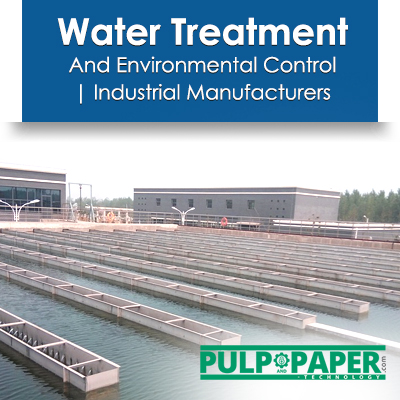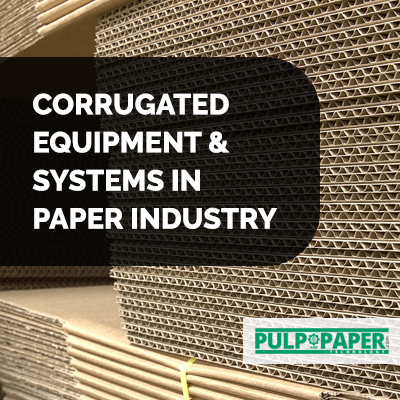Quality Assurance in Pulp and Paper: Advancements in Test and Measurement

Introduction
As the pulp and paper industry continues to evolve, ensuring quality assurance becomes even more crucial. The advancements in test and measurement technology have revolutionized this process, enabling manufacturers to achieve higher levels of quality and consistency. From testing the strength and durability of paper to analyzing chemical properties, these advancements have provided invaluable insights for product development and process optimization.
With the integration of automated systems and sophisticated instruments, paper manufacturers can now measure various parameters accurately and efficiently. This not only helps in monitoring the quality throughout production but also minimizes wastage and rejects.
In this article, we will explore the latest advancements in test and measurement techniques used in quality assurance in the pulp and paper industry. From the utilization of artificial intelligence in data analysis to the development of innovative testing devices, we will delve into the cutting-edge technology that is revolutionizing the industry.
Stay tuned to discover how these advancements are enhancing product quality, improving efficiency, and driving overall growth in the pulp and paper industry.
I. Importance of Quality Assurance in Pulp and Paper Production
Quality assurance plays a crucial role in the pulp and paper industry. With the increasing demand for high-quality products, manufacturers need to ensure that their products meet the required specifications and standards. This not only helps in building customer trust but also enhances the overall reputation of the company.
In addition, quality assurance helps in identifying and rectifying any issues or defects in the production process. By implementing effective quality control measures, manufacturers can minimize the risk of producing substandard products and improve their operational efficiency.
Furthermore, quality assurance is essential for complying with regulatory requirements. Paper manufacturers need to meet the standards set by regulatory bodies, such as the Environmental Protection Agency (EPA) and the Occupational Safety and Health Administration (OSHA), to ensure the safety of their products and the well-being of their employees.
Overall, quality assurance is vital in the pulp and paper industry to ensure consistent product quality, optimize production processes, and comply with regulatory standards.
II. Common Challenges in Ensuring Quality in the Pulp and Paper Industry
While quality assurance is crucial in the pulp and paper industry, there are several challenges that manufacturers face in ensuring product quality. These challenges include:
Raw Material Variation: The quality of raw materials, such as wood pulp and chemicals, can vary significantly. This can impact the final product quality, making it essential for manufacturers to have robust quality control measures in place.
Process Variability: The paper manufacturing process involves several stages, including pulping, bleaching, and drying. Each of these stages can introduce variability, leading to variations in the final product. Manufacturers need to closely monitor and control each stage to ensure consistent quality.
Environmental Factors: Environmental factors, such as temperature and humidity, can affect the paper manufacturing process and the final product quality. Manufacturers need to account for these factors and implement appropriate measures to minimize their impact.
Equipment Performance: The performance of testing and measurement equipment can impact the accuracy and reliability of quality assurance processes. Regular maintenance and calibration of equipment are essential to ensure accurate results.
To overcome these challenges, paper manufacturers are increasingly turning to advanced test and measurement technologies that provide more accurate and reliable results.
III. Advancements in Test and Measurement Technologies for Quality Assurance
Recent advancements in test and measurement technologies have revolutionized quality assurance in the pulp and paper industry. These advancements have enabled manufacturers to overcome the challenges mentioned earlier and achieve higher levels of quality and consistency in their products.
One of the key advancements is the integration of automated systems and sophisticated instruments. Automated systems enable continuous monitoring of various parameters throughout the production process, ensuring timely detection of any deviations from the desired quality standards. This allows manufacturers to take immediate corrective actions, minimizing the risk of producing substandard products.
Another significant advancement is the utilization of artificial intelligence (AI) in data analysis. AI algorithms can analyze large volumes of data and identify patterns and trends that may not be apparent to human operators. This helps in uncovering insights and optimizing the production process for better quality and efficiency.
Furthermore, innovative testing devices have been developed to measure various parameters accurately and efficiently. For example, advanced equipment is now available to measure the strength and durability of paper, analyze chemical properties, and detect impurities. These devices provide real-time data, allowing manufacturers to make informed decisions and take proactive measures to maintain product quality.
Overall, these advancements in test and measurement technologies have transformed quality assurance in the pulp and paper industry, enabling manufacturers to achieve higher levels of quality and consistency.
IV. Key Parameters and Tests for Quality Assurance in Pulp and Paper
In quality assurance for pulp and paper, several key parameters and tests are performed to ensure product quality. These parameters and tests include:
Burst Strength: Burst strength measures the ability of paper to withstand pressure without bursting. It is an important parameter for products such as packaging materials and envelopes.
Tensile Strength: Tensile strength measures the maximum force that paper can withstand before breaking. It is an essential parameter for products that require strength, such as paper bags and cardboard.
Brightness: Brightness measures the reflectance of light from the paper surface. It is an important parameter for printing and writing papers, as higher brightness levels result in better print quality.
Opacity: Opacity measures the degree to which light is transmitted through the paper. It is an essential parameter for products such as book pages and packaging materials, as high opacity ensures the content is not visible through the paper.
Moisture Content: Moisture content measures the amount of water present in the paper. It is crucial to control moisture content as excessive moisture can lead to dimensional changes and affect the printability and runnability of the paper.
These are just a few examples of the key parameters and tests used in quality assurance for pulp and paper. By closely monitoring and controlling these parameters, manufacturers can ensure consistent product quality and meet customer expectations.
V. Benefits of Implementing Advanced Test and Measurement Technologies
The implementation of advanced test and measurement technologies in quality assurance offers several benefits to the pulp and paper industry. These benefits include:
Improved Product Quality: Advanced technologies provide more accurate and reliable results, enabling manufacturers to maintain consistent product quality. This helps in building customer trust and loyalty, leading to increased sales and market share.
Enhanced Efficiency: Automated systems and sophisticated instruments streamline the quality assurance process, reducing the time and effort required for testing and analysis. This improves overall operational efficiency and reduces production costs.
Reduced Wastage and Rejects: By continuously monitoring the production process and detecting deviations from quality standards, manufacturers can minimize wastage and rejects. This leads to cost savings and increased profitability.
Optimized Process Control: Advanced technologies provide real-time data and insights, allowing manufacturers to optimize the production process for better quality and efficiency. This leads to improved process control and a competitive advantage in the market.
Compliance with Regulatory Standards: Advanced test and measurement technologies help manufacturers comply with regulatory standards, ensuring the safety and quality of their products. This protects the reputation of the company and minimizes the risk of penalties or legal issues.
Overall, implementing advanced test and measurement technologies in quality assurance brings significant benefits to the pulp and paper industry, leading to improved product quality, efficiency, and profitability.
VI. Trends in Quality Assurance for the Pulp and Paper Industry
The pulp and paper industry is continuously evolving, and so are the trends in quality assurance. Some of the key trends shaping the industry include:
Integration of Internet of Things (IoT): IoT technology is increasingly being used in quality assurance processes. By connecting various devices and systems, manufacturers can gather real-time data, monitor quality parameters remotely, and make data-driven decisions for process optimization.
Big Data Analytics: With the increasing volume of data generated in the industry, big data analytics is becoming essential for quality assurance. Analyzing large datasets can uncover valuable insights, identify trends, and optimize the production process for better quality and efficiency.
Quality Management Systems (QMS): QMS software is being widely adopted in the pulp and paper industry to streamline quality assurance processes. These systems help in managing quality data, tracking performance metrics, and ensuring compliance with regulatory standards.
Sustainable Quality Assurance: As sustainability becomes a key focus in the industry, manufacturers are incorporating sustainable practices in quality assurance. This includes using eco-friendly materials, optimizing energy consumption, and minimizing waste generation.
These trends are driving the evolution of quality assurance in the pulp and paper industry, enabling manufacturers to achieve higher levels of quality, efficiency, and sustainability.
VII. Training and Certification Programs for Quality Assurance Professionals
To keep up with the advancements in test and measurement technologies, quality assurance professionals in the pulp and paper industry need to continuously update their skills and knowledge. Training and certification programs play a vital role in equipping professionals with the necessary expertise.
Several organizations offer training and certification programs specifically designed for quality assurance professionals in the pulp and paper industry. These programs cover various aspects of quality assurance, including the latest test and measurement technologies, industry best practices, and regulatory compliance.
By participating in these programs, professionals can enhance their understanding of quality assurance principles, learn about the latest advancements in the field, and acquire the skills needed to implement effective quality control measures.
Additionally, certification programs provide professionals with industry-recognized credentials, demonstrating their expertise and commitment to quality assurance. This can enhance career prospects and open up new opportunities for advancement in the industry.
Quality assurance professionals must invest in their professional development through training and certification programs to stay updated with the latest advancements and ensure their organizations' success.
Conclusion
The advancements in test and measurement technologies have revolutionized quality assurance in the pulp and paper industry. From the integration of automated systems and sophisticated instruments to the utilization of artificial intelligence in data analysis, these advancements have provided valuable insights for product development and process optimization.
By implementing advanced test and measurement technologies, paper manufacturers can ensure consistent product quality, reduce wastage, and enhance operational efficiency. These technologies enable real-time monitoring of various parameters, helping manufacturers make informed decisions and take proactive measures to maintain quality standards.
As the industry continues to evolve, quality assurance professionals need to stay updated with the latest advancements through training and certification programs. This will enable them to leverage the full potential of test and measurement technologies and drive overall growth in the pulp and paper industry.
In conclusion, the advancements in test and measurement technologies are transforming quality assurance in the pulp and paper industry, leading to improved product quality, efficiency, and sustainability. Embracing these advancements is crucial for manufacturers to stay competitive in the ever-evolving market.








